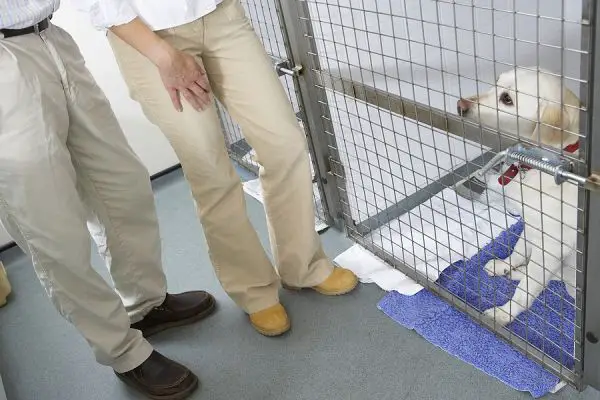
This is a placeholder text
Group text
 How to Successfully Adopt a Dog from a Rescue
How to Successfully Adopt a Dog from a Rescue
One of the kindest things any person can do is to adopt an animal from a shelter or humane society. These are animals that desperately need a home and human beings to love and care for them. However, if you have decided to adopt a dog from a rescue situation, you must go in with your eyes wide open. Dogs in shelters are there because they were no longer wanted by their past owners, who either surrendered them voluntarily or cruelly abandoned them to fend for themselves. In order for you to adopt such an animal successfully, you are going to need to be able to deal with the personality and behavioral issues that the last owners could not handle.
Before you get discouraged by the prospect of a rescue adoption, there is one thing you should realize, and it is something that should give you hope – in most instances, dogs end up in shelters because of mistakes made by the humans they lived with, not because there was actually something wrong with the dog. If you can avoid those mistakes, there is no reason you cannot find a wonderful companion for yourself and your family by adopting a dog from your local shelter.
The Human Roots of Canine Behavioral Problems
Dogs are by nature pack animals, and like all animals that live in groups they need some order and stability. For dogs, there should always be a social structure, or a hierarchy, and a dog should know his proper place within that hierarchy. When dogs are a part of a group that includes humans, it is critically important they realize humans are going to be the ones assuming leadership roles. Human beings unfortunately do not always understand this, and in their desire to be kind to a dog, they let him have his way until be begins to think it is his job to lead. Once a dog gets the idea that it is his or her duty to take on a leadership role, this sets up a dynamic where behavioral problems can begin to manifest. Overly assertive and aggressive behavior is one possible result when dogs think they are the leader of their group, and this is what causes dogs to acquire the label of “unmanageable.”In addition to aggressive or uncontrollable behavior, separation anxiety is another big reason why owners decide to get rid of a dog. A dog will cry, whine, and bark all day, drawing complaints from neighbors, and he may cause so much damage around the house that his humans become afraid to leave him home alone. Of course a dog exhibiting these behaviors is obviously unhappy, and even caring owners may think that turning him over to the local humane society so he can find a new home is for his own good.
But separation anxiety is misunderstood by most people. In a natural canine group, the leader is allowed to go off on his own, but dogs lower in the pecking order are not. When a dog exhibits separation anxiety, it is because he has been allowed to assume the leadership role in his family, and when his humans leave he is no longer able to protect or watch out for them. So in reality, he is not crying and showing distress because he cannot live without his humans, but rather, he is stressed out because he is afraid his humans cannot survive without him.
Neurotic behavior of various types is a third major reason why owners give up their dogs. Dogs are clearly under stress in their living situation, and they may begin doing harm to themselves or objects around the house, or they may start relieving themselves indoors. These dogs seem to be mentally unbalanced, and their humans feel as if they have no choice but to remove them from the home.
In situations such as these, it is highly likely that these dogs are not getting the kind of exercise they need. Dogs are natural wanderers, and being kept inside for long periods, or even being confined inside fenced yards, prevents them from getting the kind of regular, intense exercise that they truly need. Despite what you may sometimes read,all dogs need to be taken out regularly for long walks, not just certain high-energy breeds.
 Coming to the Rescue of a Rescue Dog
Coming to the Rescue of a Rescue Dog
Dogs in shelters can only be successfully adopted if the humans who take them home truly understand how a dog thinks and what he needs to feel comfortable, safe, and secure in a brand new living situation. The most important principle to remember for a successful rescue is that a dog living with humans needs to learn that the responsibility of leadership in his new group is not going to fall on his shoulders. While you might imagine that a dog wants to be the leader, and that you will have to struggle to get him to give up that idea, in reality a leadership mantle in a group of humans is something that no dog desires or benefits from. Human behavior is entirely enigmatic from a dog’s perspective, and if a dog of either sex finds themselves cast into a leadership role that dog is going to be continually frustrated by the strange and unpredictable actions of the members of the pack he is supposedly ruling.There are some basic steps you can take that will relieve a dog of the responsibility and the pressure that comes from being cast into a leadership position by unwitting human beings. The primary way that humans can show leadership to a dog is by always walking out in front, when entering or leaving the house or when out for actual walks. By always going first, the human is letting the dog know that he is being protected by a strong leader, and that he can relax and just enjoy life or be prepared to accept an order or direction. Dogs with humans should also always be kept under control, and never be allowed to just run around doing whatever they want. Also, not allowing your new dog to be food aggressive or aggressive with his or her toys is another way to ensure your place as pack leader.
When bringing home a shelter dog, all of your behavior should reinforce the idea, in one way or another, that the dog is living in a house that belongs to humans, and that he is not going to be expected to be the leader, or to have his needs and desires take precedence over anyone else’s. All of this helps a dog feel comfortable and secure, because in a wild dog pack the leader takes the responsibility of looking out for everyone else, which allows the dogs below him in the pecking order to feel protected. Strong but loving leadership, combined with plenty of exercise, should allow even the most recalcitrant rescue dog to feel safe and happy in a new home.
Respecting your Dog for Who He or She Is
Human leadership in a relationship with a dog is not about dominance or control; from the perspective of the dog it only means that he can rely on you to be there to look out for him, to give him love, and help him feel safe. Much as children rely on their parents to take responsibility for their health and welfare, so too does a dog rely on his humans to take care of him in all situations. Your rescue dogs did not have security in his former home, but now thanks to you he will finally have the chance to live happily and comfortably as an important part of a loving and supportive family.Contact information Disclaimer Privacy Statement Copyright Information Terms of Service Cookie policy ↑ Back to top





